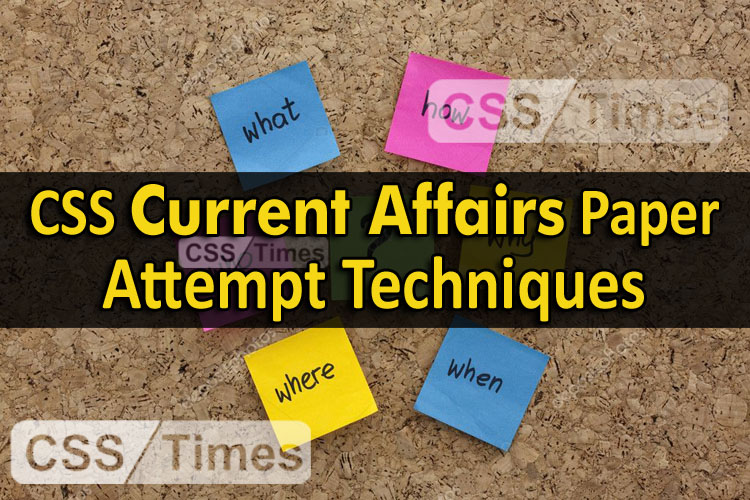Current Affairs in CSS and PMS need innovative, critical and comprehensive approach. History and unnecessary information tend to overshadow the essence of issues primarily of contemporary nature. It calls for fresh and current events based approach rather than philosophizing past and history.
1. Strategies to ace current affairs paper
i. Understanding the questions holistically
Current affairs topics are generally open-ended; do not have a planned ending, so it may develop in several ways. They are teeming with pregnant meanings, having two dimensions i.e. intellectual and practical. Unfortunately, due to lack of clinical and multi-dimensional understanding and knowledge, mostly candidates come up with unproductive work instead of balance between different dimensions. There appears to be a marked disconnect in cognitive abilities to handle a subject matter skillfully, rendering the whole exercise patchy and unconvincing.
ii. Grip on past, present and future
In a bid to deliver sound knowledge, it is required to cover all aspects of the given questions proportionately.
iii. Relevant quotations
Make sure you use cogent and convincing sayings, proverbs and maxims in accordance with the given topics.
iv. Making simple outlines for each questions
Outline tends to be a scaffold. The outlines of the questions should be properly framed and implemented both in terms of sequence and utility.
v. Headings are important
Suitable and clearly articulated headings facilitate examiner.
vi. Art of argumentation
Use both induction and deduction argument.
vii. Vocabulary and grammar
Words are the currency of communication. Use contextually well-defined vocabulary items which result in persuasion and make a good impression on examiner. Language should be errors-free.
viii. Conclusion
ix. Critical comments after conclusion
It’s important to give critical comments at the end.
2. Note: Understanding key words in questions
i. Analyze
Take apart an idea, concept or statement and examine and criticize its sub-parts in detail. You have to be methodical and logical. Break an issue into its constituent parts. Look in depth at each part using supporting arguments and evidence for and against as well as how these interrelate to one another.
ii. Asses
Describe a topic’s positive and negative aspects and say how useful or successful it is, or consider its contribution to knowledge, events or processes (this is usually about how important something is).Weigh up to what extent something is true. Persuade the reader of your argument by citing relevant research but also remember to point out any flaws and counter-arguments as well. Conclude by stating clearly how far you are in agreement with the original proposition.
iii. Clarify
Literally make something clearer and, where appropriate, simplify it. This could involve, for example, explaining in simpler terms a complex process or theory, or the relationship between two variables.
iv. Comment on/upon
Pick out the main points on a subject and give your opinion, reinforcing your point of view using logic and reference to relevant evidence, including any wider reading you have done. Both pros and cons are presented based on one’s critical thinking.
v. Compare
Identify the similarities and differences between two or more phenomena. Say if any of the shared similarities or differences are more important than others. ‘Compare’ and ‘contrast’ will often feature together in an essay question.
vi. Contrast
Similar to compare but concentrate on the dissimilarities between two or more phenomena, or what sets them apart. Point out any differences which are particularly significant.
vii. Consider
Say what you think and have observed about something. Back up your comments using appropriate evidence from external sources, or your own experience. Include any views which are contrary to your own and how they relate to what you originally thought.
viii. Critically Evaluate
Give your verdict as to what extent a statement or findings within a piece of research are true, or to what extent you agree with them. Provide evidence taken from a wide range of sources which both agree with and contradict an argument. Come to a final conclusion, basing your decision on what you judge to be the most important factors and justify how you have made your choice.
ix. Criticize
Point out a topic’s mistakes or weaknesses as well as its favourable aspects. Give a balanced answer (this will involve some analysis first).
x. Demonstrate
The key to tackling ‘demonstrate’ questions is to use several examples, evidence, and logical arguments. Essentially, you are required to show how a particular research topic or argument is valid by using evidence and arguments to support your claim.
xi. Define
To give in precise terms the meaning of something. Bring to attention any problems posed with the definition and different interpretations that may exist.
xii. Describe
Provide a detailed explanation as to how and why something happens.
xiii. Discuss
Essentially this is a written debate where you are using your skill at reasoning, backed up by carefully selected evidence to make a case for and against an argument, or point out the advantages and disadvantages of a given context. Remember to arrive at a conclusion. All aspects like political,social,cultural and economic dynamics are explored.
xiv. Justify
Make a case by providing a body of evidence to support your ideas and points of view. In order to present a balanced argument, consider opinions which may run contrary to your own before stating your conclusion.

2 replies on “CSS Current Affairs Paper Attempt Techniques (By: Saeed Wazir)”
Wazir Saab I want to meet u and kiss u for the tips. I attempted a top class paper